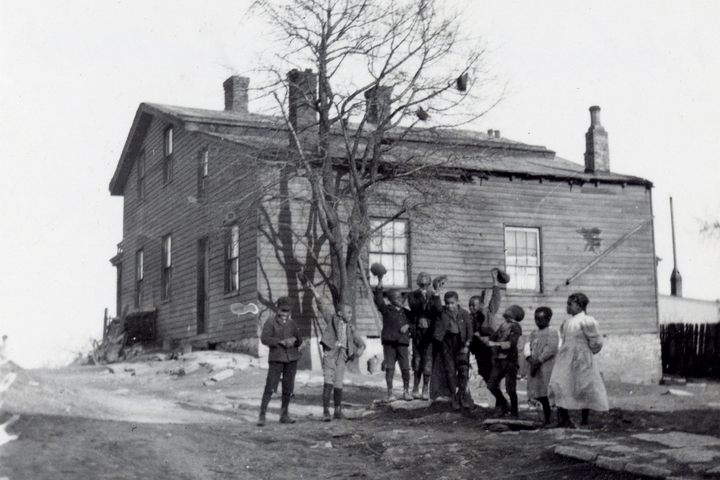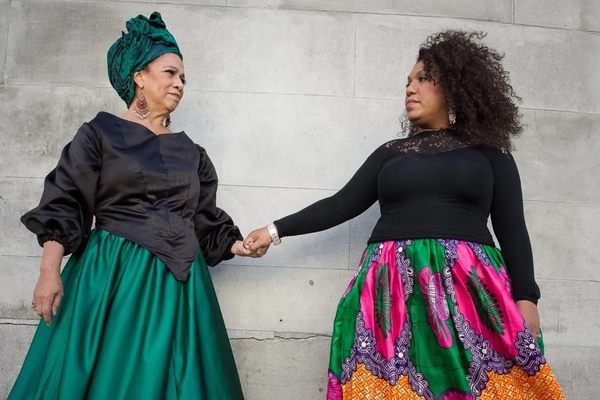
The Underground Railroad Was the Ultimate Conspiracy to Southern Enslavers
And justified the most extreme responses.
From Under the Eye of Power by Colin Dickey, published by Viking, an imprint of Penguin Publishing Group, a division of Penguin Random House, LLC. Copyright © 2023 by Colin Dickey.
Even today, no one is even sure precisely where the name originated. Some have traced it to an account from 1839, when a young Black man was caught “lurking” around the Capitol in Washington, D.C.—when asked how he got there, he said that he had been sent north by a “railroad which went underground all the way to Boston.”
Through a loose network of formerly enslaved and free Black Americans, along with their white allies, thousands of enslaved Americans made their way north in the decades before the Civil War, moving sometimes surreptitiously, sometimes out in the open, on railways and ships, in wagons and freight, toward freedom. It is impossible now to know for certain how many people made their way out of slavery on the Underground Railroad; both supporters and detractors had an investment in embellishing its impact. In the North, abolitionists dramatized the plight of those seeking refuge and to play up their own heroic efforts. In the South, enslavers argued that the Underground Railroad was nothing short of a grand conspiracy of subversive lawbreakers—the higher the numbers, the greater the threat to the country.

There was never a literal railroad, but the term stuck because it resonated with strange grace and radiance. Wherever the term came from, once America had seized upon it, it became a powerful metaphor. There were “stations” and “conductors.” Jermain Loguen, who’d escaped slavery and made it to Canada in 1834, returned regularly to Syracuse, New York, to help others, raising funds by referring to himself as a “depot on the Underground Railroad.” A group of enslaved people held in prison in New York City were slated to be returned to the South when they were broken out by a group of abolitionists; the papers at the time reported that the underground railroad “runs directly under the prison in New York, and … the slaves let themselves down through a stone trapdoor into one of the cars.”
But it wasn’t just the idea of a railroad—there was also the underground. Tucked back in a small neighborhood not far from the Brooklyn Bridge, among rows of expensive brownstones, is Plymouth Church, which became known as the “Grand Central Depot” of the Underground Railroad, for its prominence in the abolitionist cause. There, Henry Ward Beecher held “mock slave auctions” to raise money to buy emancipation, and fugitives were brought there on multiple occasions. Plymouth Church (architecturally unchanged since its founding) has no closets or offices in the main church, nor does it have an attic; all it has is a simple basement, consisting of a series of low brick walls and archways. Lois Rosebrooks, who led tours of the church for decades before her retirement in 2015, says that though we can’t say for sure, if fugitives were hidden in the church on their way to safety, it would have likely been in the basement.
The first half of the 19th century was a time of increasing interest in the subterranean. It was a hidden world, where nothing was as it seemed and everything was a front for a criminal organization. The whole city was just a cryptogram waiting to be decoded. The most popular book in the country in 1845 was George Lippard’s serial novel, The Quaker City: or, The Monks of Monk Hall. Part of a new genre of “city mysteries” novels, it portrayed a secret world of villainy, where a criminal underground operated out of a literal underground catacomb beneath the titular building. Monk Hall is described as a “large and magnificent mansion,” ostensibly a private residence, but within its doors, young professionals—law students, doctors, merchant’s clerks—are enticed with gambling and prostitution, gradually becoming ensnared in a criminal web run by the novel’s archvillain, Devil-Bug. Below Monk Hall’s three-story façade is a three-level basement, each floor separated by hidden trapdoors, leading further into the depths of depravity.

The surface world was not to be trusted, and ordinary explanations no longer sufficed. In the decades leading up to the Civil War, everything was connected, nothing was as it seemed. The newly urban world demanded an eye that saw beyond surfaces and sought out hidden networks. The Underground Railroad was just one more subterranean plot, one more secret network of lawbreakers chiseling out the foundations of the country. As the nation found itself unable to avoid a confrontation over slavery, this paranoid vision shaped that narrative, too. Those who sought their freedom, Southerners believed, did not work alone, nor were they capable of imagining liberty for themselves without being controlled by their abolitionist puppet masters.
If there was a single term to describe the mood in the South in the years leading up to the Civil War, it was “paranoid.” Southern enslavers feared abolitionists, and they feared those they enslaved. They lived in a state of perpetual terror, albeit one that could never be openly referenced. The “peculiar institution” depended on a peculiar kind of denial, one in which the grossly unnatural condition of bondage had to be misrecognized as a benign, divinely sanctioned institution. Southerners reassured themselves that they treated the people they kept in bondage well, and, as such, the enslaved had no cause to complain, and were even happy in their lot. The absurdity of such a position only reinforced its absolute necessity.
Contrary to the stories enslavers would tell themselves, that Black men and women were happy being enslaved, escapes were so common that printers sold stereotype “runaway slave” icons to newspapers to be used in classified ads by enslavers. There was even a “medical” term for the desire to escape: drapetomania. The reality was obvious everywhere you looked, but no one could name it outright. As a result, the South became infused with, and ultimately gripped by, conspiracy theories—conspiracy theories that were born out of attempts to explain away this obvious discrepancy. If enslaved people were naturally happy being in bondage, as Southerners anxiously tried to tell themselves, then their desire to run away must be the result of external provocations.

In an 1835 speech, future president and Virginian John Tyler captured much of the prevailing sense of paranoia and fear of the day. “The unexpected evil is now upon us,” he cried; “it has invaded our firesides, and under our own roofs is sharpening the dagger for midnight assassination, and exciting cruelty and bloodshed.” Men like Arthur Tappan and William Lloyd Garrison had perverted the post office to their ends, and they hid behind religion in an attempt to foment anarchy. With an abuser’s logic, Tyler argued that abolitionists were not “friends” to enslaved Americans but their “enemies,” since their agitations drove enslavers to crack down harshly on those in bondage. Even worse, for Tyler, was the number of women who seemed to have joined the crusade: “woman is to be made the instrument of destroying our political paradise, the Union of these States,” he lamented; “she is to be made the presiding genius over the councils of insurrection and civil discord.” For not only were women joining the abolitionist crusade to divide the Union, they were indoctrinating their children, so now “the youthful imagination is filled with horror against us and our children by images and pictures exhibited in the nursery.”
Tyler’s tirade (along with many other similar outbursts) was in part driven by massive technological advances happening during the time that had dramatically changed the landscape. The introduction of the steam engine to printing presses allowed for a new proliferation of periodicals, including (but of course by no means limited to) antislavery texts. The American AntiSlavery Society was distributing 122,000 pieces of literature in 1834; a year later, that number had increased almost tenfold, to 1,100,000. Using mailing lists provided by sympathizers and the postal service, Garrison and Tappan could wallpaper the South with abolitionist arguments. Southerners couldn’t understand how such a “mere handful of obscure persons” (in Tyler’s words) could disseminate so much material, and ultimately decided that there must be money coming from abroad, alleging that foreign saboteurs were in league with abolitionists. (This, of course, wouldn’t be the last time a new technology would spur a flood of new conspiracy theories, as evidenced by the proliferation of paranoia brought on by the Internet and social media.)
Rather than see this printing innovation as proof of American ingenuity, slavers took it as proof of subversion; any attack on them was an attack on the United States itself. W.W. Sleigh’s Abolitionism Exposed! conceived of America as “the cradle of republicanism,” and as such a bane on the existence of European monarchies, who stirred up abolitionism dissent from afar to bring down democracy. Unlike Tyler, Sleigh suggested that American abolitionists were in fact “actuated by the purest motives of doing good to all,” but were being manipulated by “some crafty, designing persons … behind the curtain.” Either way, though, proponents of slavery accused abolitionists and their allies of bringing factionalism into American politics, sowing discord as an attempt to bring down the Union, and implicitly reaching back to Washington’s Farewell Address, which had explicitly warned of such troubles.

And this is why the idea of the Underground Railroad became so powerful. On the one hand, it’s fair to say that it was a secret, subversive society, dedicated to breaking the law and overturning the United States Constitution. William H. Seward spoke for many when he said that “there is a higher law than the Constitution.” Complying with the Fugitive Slave Act, abolitionists like him believed, conflicted with the “laws of God.” But while a veteran of the Underground Railroad would later describe it as a “deep-laid scheme,” it’s not wholly accurate to describe it as a secret society; it was more a loose network of likeminded figures working, sometimes independently and sometimes in tandem. There was no central organizing committee or enduring structure; at its height it was never more than a semi–ad hoc network of loose confederates, all united behind the same ideal. It was safer this way, anyway; a highly centralized group could have easily been brought down, whereas a guerilla network of unconnected cells stood a much more robust chance of persevering. The idea of a highly organized system of tunnels, codes, safe houses, and networks is mostly a fiction, but a useful one.
This organization was its strength, and its limitation. For one thing, the secrecy—while necessary—also put an upper limit on what could be accomplished. Because anti-abolitionist mobs broke up meetings, chased down lecturers, and destroyed property, much of this work had to be clandestine; Anthony Lane, treasurer of the New York Vigilance Committee, later recalled that they “dare not” advertise their meetings publicly, since fugitives often attended, and thus meetings could have been easy targets for slave catchers. Such secrecy often hampered fundraising and prevented the kind of widespread coordination that Southern conspiracy mongers assumed was happening.
But even when offered the chance for a more robust conspiracy, abolitionists rejected it. John Brown had at one point proposed a fortified series of underground railroad depots that could be used for a massive, sustained operation of emancipation, but sharing his idea with trusted sympathizers gained him little support. What abolitionists wanted was less a highly coordinated and organized network than the idea of such a thing, something that gave them common cause and purpose. Among these disparate and loosely affiliated actors, the concept of the Underground Railroad gave a concreteness to an otherwise ad hoc and fragmented group.

But it also had the side effect of allowing for an imaginary villain among enslavers, a shadowy organization of lawbreakers, to which one could attach all manner of conspiracy theories. As with other notorious secret societies of the age—the Illuminati, Freemasons, and others—the less directly visible the Underground Railroad was, the more work it could be accused of accomplishing behind the scenes. And by shifting the focus from the problem of America itself to some kind of phantom attacker, they could hope to provide a cause that all (white) Americans needed to unite behind. Virginia secessionist Edward Ruffin lamented in 1857 of the “ability of the abolitionists to operate on our slaves, to infuse discontent, and to seduce them to abscond, or to rebel.… ” There were “organized associations for stealing slaves, and exciting insurrection and massacre,” he warned, that “have now every facility to enter the country, and to sojourn wherever they can best operate.” No Northerner could be trusted, since any “pretext of business is enough to serve to account for their presence; and there is no neighborhood in the Southern States into which Yankees have not penetrated.” Similarly, William Henry Drayton of South Carolina wrote of abolitionist “conspirators, at their midnight meetings, where the bubbling cauldron of abolition was filled with its pestilential materials, and the fire beneath kindled by the breath of the fanatics…. ” And the Mississippian worried of how “the conspiracies detected among the slaves in Tennessee, Kentucky, South Carolina, and Texas show that the vile emissaries of abolition, working like moles under the ground, have been secretly breathing the poison of insubordination into their minds.”
Again and again, conspiracy theories about secret societies became a way to massage these hypocrisies and smooth over their prickly surfaces. Perhaps the hypocrisy was not with slavery. Perhaps America itself was fine, but some subversive element had gotten in there, twisting the facts and confusing the weaker-brained. Perhaps what seemed like a contradiction was only the machination of wily abolitionists, stirring up trouble.
If Southern forces were amplifying rather than downplaying the effectiveness of the Underground Railroad, it was in no small part because it gave them freer license to implement anti-American crackdowns and administer extralegal violence. It also allowed them to massage their own cognitive dissonance. America’s founding—as a nation of democracy and liberty where men and women were forcibly kept in bondage—involved a hypocrisy so rank it could never be fully acknowledged outright and could only be approached obliquely. Conspiracy theories—particularly those involving secret, subversive societies—were absolutely essential as one of many tools that enslavers and their sympathetic allies used to avoid confronting the country’s original sin.

Southern leaders regularly used conspiracy theories surrounding slave insurrections to attempt to curtail First Amendment freedoms. In 1829, a Black clothing dealer named David Walker authored a pamphlet titled “An Appeal to the Colored Citizens of the World.” When a parcel of 60 copies showed up in a Savannah warehouse that December, there was an immediate panic and ensuing crackdown. It hardly mattered that most enslaved Americans were illiterate; the presence of the pamphlet and other abolitionist materials led to severe restrictions on what could be mailed through the post office and distributed in the South. Such conspiracy theories were hardly spontaneous, inchoate eruptions of emotion. They were deployed to achieve specific aims, often thought through well in advance. In the North, where enslavers could not control the post office or the press, they turned to sympathetic Democrats to instigate mobs and riots. Georgia Democrat John Forsyth wrote to presidential hopeful Martin Van Buren in 1835 with just such a request, suggesting that “a little more mob discipline of the white incendiaries would be wholesome … and the sooner you set the imps to work the better.”
The main goal of these conspiracy theories seemed to have been twofold: to reassure Southern enslavers that what they were doing was morally right, and to justify any act of violence or suppression necessary to maintain slavery. Such seemingly anti-American crackdowns on free speech in the South could only be logically maintained if they were cast as a reaction to an anti-American subversive element. In cases where those in power felt the need to suppress such inconvenient thought, the question was how to do this without seemingly reneging on that promise of free speech and open debate. Whispers of subversive societies offered the best and most expedient way of accomplishing this; alleging extra-democratic instigators whose speech was simply out of bounds allowed for suppression without fear of cognitive dissonance.













Follow us on Twitter to get the latest on the world's hidden wonders.
Like us on Facebook to get the latest on the world's hidden wonders.
Follow us on Twitter Like us on Facebook